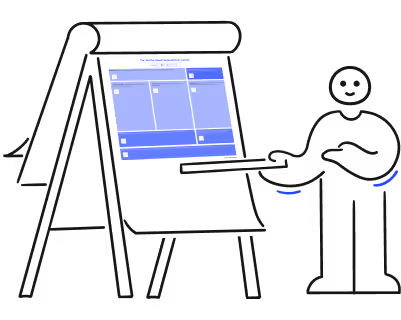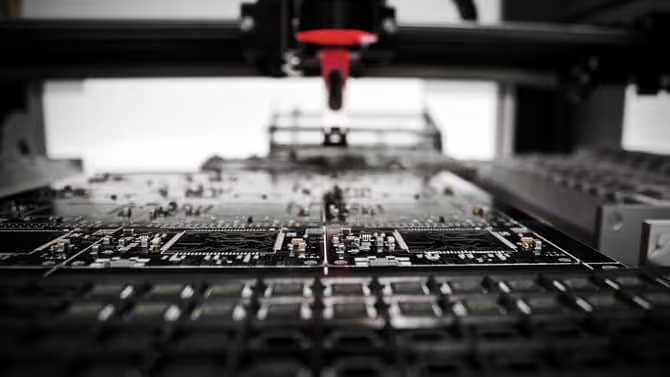The age of AI-Human collaboration will transform the way we work forever

Empower your organization with the skills-based canvas.

Meet your new employee of the month (and of the decade): AI. Artificial intelligence used to be the stuff of sci-fi movies - a distant promise of a distorted future. No longer. AI will soon be as ubiquitous as electricity or the Internet, and will usher in the 4th industrial revolution. In fact, it's already underway and it's transforming the way we work... forever.
From natural language processing to machine learning, AI is creating new opportunities for collaboration between humans and machines, allowing the workforce to focus on more valuable tasks while giving less valuable ones to machines.
In fact, calculations estimate that AI could add $15 trillion to the global economy by 2030. AI is not a fad but a paradigm shifter, set to become the backbone of the all-digital world and the next frontier for the workforce worldwide.
In this article, we explore how AI-human collaboration is changing the workplace, what jobs and tasks have been affected… and what the future holds for AI and the workforce.
AI-induced white-collar blues: the impact of artificial intelligence on office jobs
The 20th-century industrial revolution changed blue-collar work forever with machinery and automation taking over factory floors to make work faster and safer for all.
Now, the next great industrial revolution is happening. And this time, it will affect white-collar jobs as well. AI will replace some jobs while displacing others. But more significantly, it will augment workers and create new jobs too.
More than ever, the need to upskill or reskill with AI will become paramount to the success of organizations and the employability of workers. According to the World Economic Forum, 50% of us will need to reskill by 2025, as the "double-disruption" of the economic impacts of the pandemic and increasing automation transforming jobs takes hold. Organizations must build with agility and adaptability to take advantage of technology and its new darling: AI.
AI-human collaboration is the future of work and HR leaders must prepare for it. Technology will change the way we hire, train and retain talent.
Putting AI to work: 10 examples of AI-human collaborations
These days, ChatGPT is all the rage. Its popularity has given us a glimpse into the future of how game-changing AI assistants will be for human productivity. While some knowledge workers fear AI could replace them, the most future-forward companies and individuals understand that putting AI to work as a copilot for tasks will grant them a competitive edge.
Here are examples of existing professions already benefiting from AI to automate the minutiae, maximize productivity and scale their impact:
- Customer service: AI has the ability to learn from past tickets to automatically build custom answers, which can save a ton of time to customer service representatives.
- Email marketing: AI algorithms can be your personal coach for email marketing, analyzing customer data to optimize email content and subject lines. The result? Higher open and click-through rates, like scoring the winning goal in a game.
- Content writing: AI can be your brainstorm buddy, assisting in generating content outlines and providing suggestions for improvements to increase readability and engagement. Think of it as having a co-writer who always has your back.
- Programming: AI can be your trusty sidekick, assisting in coding, testing, and debugging software. This leads to faster development cycles and enables you to save the day for your clients, like a superhero team working together.
- Graphic design: AI can be your design genie, assisting in designing graphics and layouts based on user preferences or with image generation. Who doesn’t want faster turnaround times and improved user engagement? AI can create magic that delights your audience quickly.
- Recruitment: AI can be your talent scout, assisting in writing job descriptions, screening and evaluating candidate resumes — resulting in more efficient hiring processes and helps you build your dream team, like a coach building a championship team.
- Data analysis: AI can be your data wizard, assisting in data analysis and decision-making. This results in more accurate and timely insights that can help you make better decisions, like having a crystal ball to predict the future.
- Sales forecasting: AI can be your fortune teller, assisting in predicting sales trends and identifying growth opportunities for a stronger bottom line. It can help you stay ahead of the competition, like a team that always scores before the buzzer.
- Project management: AI can be your assistant, helping manage project timelines, allocating resources, and identifying risks. Think smoother project completion and your team being always one step ahead, with everything kept on track.
- Language translation: AI can be your language ninja, assisting in translating documents and content accurately and quickly. Faster communication and expanded global reach on demand — your very own multilingual team who can communicate with anyone, anywhere.
TL/DRL: AI is quickly becoming everyone’s favorite and most reliable colleague, helping boost productivity and achieve faster results by allowing workers to spend less time on repetitive, mind-numbing tasks. Enhancing employees' skill sets with AI can actually make work more fulfilling — humans can focus on their higher value tasks and create better work-life balance, while AI takes care of the minutiae.
Artificial Intelligence will likely create more jobs than it will destroy
News headlines often equate technological advancements with job disruption. But if history tells us anything, it's that technology leaps inevitably lead to the creation of new needs and more jobs.
For example, the advent of social media created an entire new stream of jobs, with now hundreds of thousands of social media managers in the world — a job title that didn't exist 15 years ago.
AI will likely do the same for our job market, creating more jobs than it will displace. We are already seeing glimpses of that future. Even if it is estimated that up to 14% of the global workforce (375M workers) will have to change jobs by 2030, AI integration will prompt the surfacing of innumerable net new jobs — more than we could have ever imagined.
- AI Copywriter: Writer's block no longer has to get in the way of creativity. With the help of AI, content creators can generate endless writing prompts to spark their imagination and spend more time on creative copywriting.
- AI Developer: Also referred to as an AI engineer or a machine learning engineer, the name says it all: AI developers are becoming more and more needed, not only to develop artificial intelligence but to also integrate it into software and applications.
- NLP Engineer: Natural Language Processing (NLP) engineers specialize in human language, including spoken and written information, focusing on improving the voice assistance, speech recognition and document processing aspects of AI.
- BI Developer: Business Intelligence (BI) Developers generate and manage the business interface — organizing business data, extracting insights, and keeping a close eye on market trends.
- AI Safety Agent: Such roles are linked to AI alignment, ensuring the existential and technical safety of AI processes, optimizing them for researchers and developers.
- AI-Generated Photo Editor: AI can do the heavy lifting when it comes to generating high-quality images thanks to its advanced algorithms so that photographers can spend more time being creative in their editing process of the final product.
- VR Experience Designer: The world of entertainment and training is about to get a lot more immersive and Virtual Reality (VR) Designers are masters of AI tools in order to create mind-blowing virtual reality experiences that transport users to entirely new worlds.
- Digital Transformation Consultant: The digital age is here to stay, and businesses need to adapt to stay competitive. Consultants will be able to guide organizations investing in the right kind of AI assets, assisting them in their digital transformation, and helping them achieve growth and innovation objectives.
Friend not enemy: AI-Human collaboration is an opportunity, not a threat
While there may be some apprehension around AI replacing human jobs, it’s essential to understand that AI-human collaboration is not about replacing people, but rather about augmenting their capabilities.
Most of us are quite excited about AI! In fact, 81% of employees believe AI improves their productivity and overall performance at work — which is awesome.
AI-powered machines can take on the more mundane, repetitive tasks, freeing up time for employees to focus on the more engaging and strategic aspects of their jobs. The benefits of AI-human collaboration unlocks an abundance of opportunities:
1. Making work more meaningful by removing redundant, mind-numbing tasks and focusing humans on higher-value outputs.
AI can take on tasks that are repetitive and mundane, allowing employees to focus on higher-value tasks.
{emphasize}
AI-powered chatbots can handle customer inquiries, freeing up human customer service representatives to handle more complex issues. This not only makes work more interesting and engaging for employees, but it also increases productivity and job satisfaction.
{emphasize}
2. Make organizations more efficient and profitable.
AI can help businesses streamline their operations, resulting in greater efficiency and profitability.
{emphasize}
AI-powered supply chain management systems can optimize inventory levels and shipping routes to reduce costs and improve delivery times. Similarly, AI can be used in predictive maintenance to detect and fix issues before they cause downtime, thereby reducing costs and increasing productivity.
{emphasize}
3. Helping you leapfrog to offer better customer service and experiences to customers.
Thanks to automation, AI can be used to provide customers with faster and more personalized service, which can lead to higher levels of customer satisfaction and loyalty.
{emphasize}
AI-powered chatbots can provide 24-7 support, answering customer questions and resolving issues in real-time. This not only reduces the workload of human customer service representatives but also improves the customer experience by providing instant and efficient solutions. AI can also be used to personalize marketing messages and offers based on individual customer behavior and preferences, leading to higher conversion rates and customer lifetime value.
{emphasize}
Opportunities are yours for the taking! But act quick. 35% of companies worldwide are already using AI and 42% are exploring AI options for future implementation.
The companies that are hesitant to embrace AI-human collaboration and innovation will quickly find themselves at a disadvantage, both in terms of the speed of innovation and the agility required to adapt to new technologies.
Adopting AI to unlock new skills and advance career progression
Upskilling and reskilling will become imperative in the age of the AI-augmented workforce for any business model. As constant change becomes the new norm, companies and employees will need to invest in their capabilities in an ongoing fashion. Turns out AI is there for that!
Workleap Skills is a prime example of putting AI to work at the service of human potential. Its AI-powered skill mapping tool helps map your teams' skills and identify gaps in a matter of minutes. This ensures HR managers spend more time on workforce planning and designing career progression paths by saving them the countless hours manual processes used to take when updating skills in Excel spreadsheets.
If your company has yet to embrace AI-human collaboration, there's never been a better time to start and we’re happy to take you for a Skills test drive.
The future of work is here, and the AI-augmented workforce is leading the way. Those who embrace this change will be better equipped to meet the demands of a rapidly changing business landscape. It’s time to prepare for the future — are you ready?
Monitor, support, and optimize your team's professional development.


%20(1).avif)


.avif)
.avif)


.avif)




